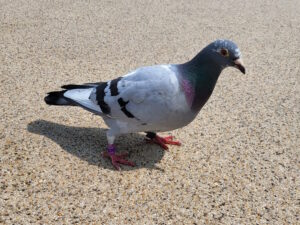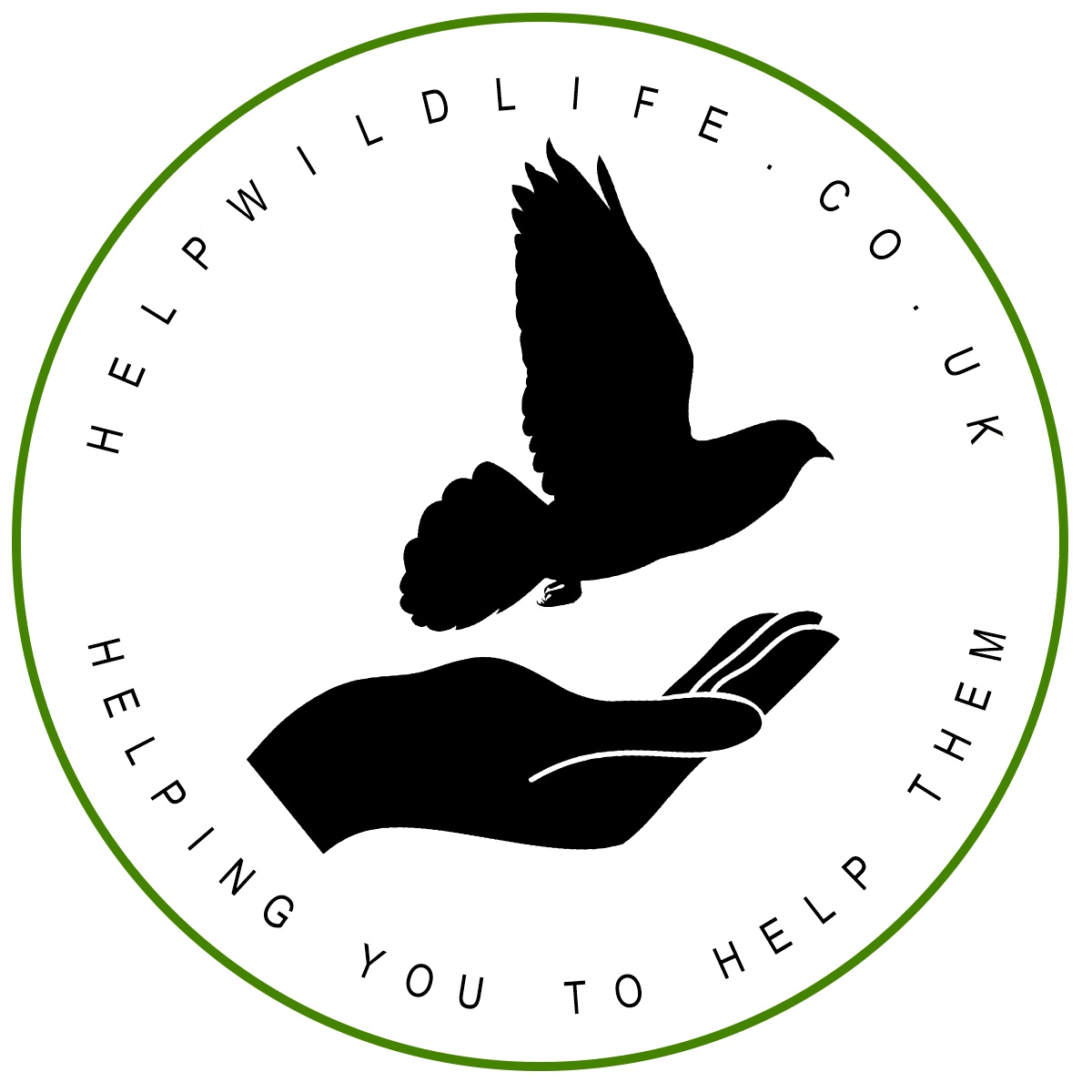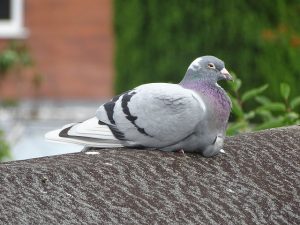Although not actually wildlife, lost racing pigeons are the cause of thousands of calls to wildlife rescues each year, so an issue which needs to be covered here. After years of picking up the pieces we are not fans of the “sport” of racing pigeons. Essentially it involves releasing domesticated animals into the wild and taking a gamble on whether they can survive long enough to make it home.
If you wish to read more on our experiences and thoughts on pigeon racing you can do so here, but otherwise read on for advice on what to do if you find a lost one.
How to Know if a Pigeon is a Racing Pigeon #
 Racing Pigeons will always wear at least one ring. This will be a coloured ring with a series of letters and numbers on it. If they’re partaking in a race, they may also have a solid, dark ring on the other leg as well.
Racing Pigeons will always wear at least one ring. This will be a coloured ring with a series of letters and numbers on it. If they’re partaking in a race, they may also have a solid, dark ring on the other leg as well.
If the pigeon has no rings, they’re most likely a wild pigeon. If they have a plain band with only 1 or 2 numbers on, or a phone number, they may be another breed of domesticated pigeon. If you’re unsure, send us a picture of the bird through the form at the bottom of this page and we can advise further.
When Does a Racing Pigeon Need Help? #
Sometimes when you see a Racing Pigeon in the wild they’re just out exercising or they’re resting before finishing a race. Some stray birds even integrate with wild flocks. Below we’ve set out the main ways you might see a Racing Pigeon and what to do. Click on the headings to expand.
Flying About Happily With Wild Birds
If you happen to see a ringed bird as part of a wild flock, and the bird appears fully integrated into the flock, looks in good condition and isn’t injured or unwell, you can leave well enough alone. Some racing pigeons are lucky and sensible enough to join a wild flock and, in this scenario, they learn wild behaviour from the flock and usually go on to have a normal wild life.
Flying About on Their Own, Keeping Their Distance From People
Racing Pigeons are raised around humans so they associate people and houses with safety. They’re usually smart enough to hang around people when they need help. If a Racing Pigeon is keeping their distance, they’re probably ok. Monitor them if you can and see if their behaviour changes.
Staying Close to People or Houses
In this scenario, the bird is likely lost and looking for a place of safety. It may be that they just need to rest and refuel before continuing their race so start by putting out some wild bird seed and water. If they don’t continue on their way after a couple of days, they’ll need some help.
Staying Close, Acting Tame, Likely Able to be Hand-Fed or Picked Up
Birds with this behaviour usually need help. They’re lost, hungry, exhausted, and dehydrated. Please get them contained in a box and make a note of the ring number.
Unwell, Injured, or Attacked
 An unwell bird may sit in one spot for a long time, fluff up their feathers, and tuck their head down into their shoulders. If they’re injured, you may see blood or notice one wing hanging lower than the other. If a bird has been caught by a predator (e.g. cat, dog, or bird of prey), they need medical attention. In all these cases, the bird needs urgent help. Please get them contained in a box and make a note of their ring number.
An unwell bird may sit in one spot for a long time, fluff up their feathers, and tuck their head down into their shoulders. If they’re injured, you may see blood or notice one wing hanging lower than the other. If a bird has been caught by a predator (e.g. cat, dog, or bird of prey), they need medical attention. In all these cases, the bird needs urgent help. Please get them contained in a box and make a note of their ring number.
Deceased
Racing Pigeon mortality is high with over 40% of birds failing to find their way home each year so it’s not uncommon to find dead Racing Pigeons. Sometimes you might only find a ringed leg which a predator opted not to eat. Please make a note of the letters and numbers on the ring and follow the advice on Tracing the Owner below.
Catching a Racing Pigeon #
If the pigeon appears to need help because they are staying close to people, unwell or injured, the most important next step is to get them contained. All the while they are ‘loose’, they are at risk from predators and could fly away if spooked and then miss out on getting help.
Racing Pigeons are often tame enough that you can pick them up quite easily but, if not, a simple, home-made box trap is often successful.
 As described in the poster, prop a box or laundry basket up with a stick and put food and water underneath. Make sure this is the only food and water on offer. When the bird goes under the box, pull on the string to move the stick and drop the box over the bird.
As described in the poster, prop a box or laundry basket up with a stick and put food and water underneath. Make sure this is the only food and water on offer. When the bird goes under the box, pull on the string to move the stick and drop the box over the bird.
You can also try making a trail of food into a shed or garage. Once contained, make a note of the letters and numbers on the ring and do not release the bird. Keep them safe and make sure they have access to water.
Tracing the Owner #
All Racing Pigeons will be wearing a ring with a unique code on it which enables the owner to be traced. The ring will usually follow the format of 2-4 letters (which represent the club the bird is registered with), a 2 digit number (representing the year the bird was ringed), a letter, then 5 numbers. e.g. GB25A12345, NEHU24Z98765. In order to trace the owner, you’ll need to note every digit of the ring code.
If the ring starts with GB, the bird is registered to the Royal Pigeon Racing Association and you can text the ring code, with no spaces, to 07888 860186. You’ll then receive an automated response with the owner’s information.
For rings beginning with different letters, the RPRA has a guide of who to contact here.
Sometimes you may find another ring which has a phone number on it or you may see an ink stamp on the pigeon’s wing which contains a phone number. In these cases, you can just telephone the owner directly.
If the rings look significantly different to the description above e.g. they only have 1 or 2 numbers on them, it’s likely this is another type of domesticated pigeon. It can be harder to trace the owner is these cases but get in touch with us via the form at the bottom of the page and we’ll try to help.
What Should the Owner Do? #
Most pigeon clubs have a Code of Conduct which requires the owner to take responsibility for any stray birds. The exact requirements and how well this is enforced varies however.
In our view, the only way to ensure that a lost, compromised bird gets home safely is for the owner to collect the bird, or arrange for a courier or other fancier to collect the bird.
Commonly, you may find the owner asks you to provide the bird with a few days bed and board and then release it to find its way home. Frankly, this is a way for the owner to avoid taking responsibility for the bird and we would strongly advise against it. There may be a good reason why the bird has failed to find its way home, such as a health issue or simply a lack of fitness, which has not been rectified by a short rest. Releasing an unfit bird is likely to constitute a breach of the Animal Welfare Act for which you, not the owner, would be liable. The bird could have a long journey home and will have to evade predators, power lines, poor weather etc en route. Even under ideal circumstances many racing pigeons don’t make it home and these would be far from ideal circumstances, not least because the bird won’t have its flock of loft mates flying alongside as it would in a race.
Will the Owner Kill it? #
As in any group of people there are good and bad. In our experience, there is a significant proportion of pigeon racers who will ‘cull’ birds which have failed to ‘perform’ well. Requiring the owner to have the bird collected is a good way to weed out these owners – they’re unlikely to go to that trouble and expense for a bird they’re going to kill. Don’t be afraid to ask the owner what will happen to the bird. If they’re unwilling to collect or say they don’t want or will kill the bird, we can help you to find the bird a new home or sanctuary placement.
What if I Need More Help? #
If you’ve followed the advice above and you’re not sure what to do, can’t trace the owner, or the owner doesn’t want the bird, you can use the form below to reach out to us for further advice and assistance.
Please note, we can only help with birds in the UK. Our volunteers are generally available Monday – Sat 09:00 – 21:00 and 13:00 – 18:00 on Sundays. If the bird is contained and appears sick or injured, please take them immediately to a local vet.





